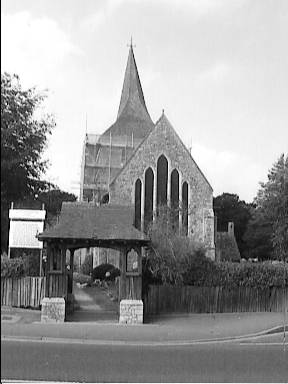![]()

![]()

St Mary's Church, South Hayling, currently undergoing major restoration and surrounded by scaffolding
33. St Mary's South Hayling
The sturdy tower and spire of this 13th century church, built as a priory church by the monks of Jumieges Abbey, peep out above the trees of the large churchyard. Entrance to the church is by the fifteenth century oak porch on the south side which is overshadowed by a massive yew tree now propped up to save it from collapse.
On first impression the interior is gloomy but closer inspection reveals many points of interest. The kings post roof timbers are very fine and are mostly original, though the granite piers of the nave pillars date from a restoration of 1892. Above the arches are attractive circular celestory windows with deep splays. The large west window is dedicated to the memory of Lord Robert Brundenell-Bruce a cousin of the famous Lord Cardigan who led the charge of the Light Brigade at Balaclava. The stained glass dates from 1915 and shows eight saints and prophets such as Moses, St George and King Solomon. Below the sill is an oak carving of a tower on a rock which once formed part of the altar reredos.
Very unusually there are two fonts in the church. Near the centre aisle is a rather battered one of Saxon origin dug up near the old vicarage in the nineteenth century. The rough carvings are badly worn. Near the north west corner is the original thirteenth century font. The shafts have sculptured heads, one being part human part reptile with pointed ears.
There are numerous sculptured heads to be seen on the corbels of the nave arches. Two on the south side probably represent King Edward I and Queen Eleanor. Others show tonsured monks and a bishop and mitre whilst above the pulpit is a man with curled hair.
Pass under the belfry into the large and imposing chancel. It is dominated by a splendid eye-catching East Window. The stained glass of the five lancets dates from 1917 and portrays 62 Biblical saints, prophets and patriarchs. The central lancet is the longest and shows 9 pairs of figures such as the Apostles Barnabas and John the Baptist. The two adjoining lancets, slightly shorter, comprise of eight pairs each all of Old Testament prophets such as Elijah, Samuel, Abraham, Amos, Malachi and so on. The two outside lancets show six single figures of New Testament saints including James, Philip, Thomas, Matthew and Bartholomew. Binoculars would be useful for studying this fine window.
Near the altar on the south wall is the most modern window in the church, designed by Alan Younger in 1994 as a tribute to the Reverend Owen Fulljames (1901-90). He was a former naval chaplain and Canon of St Paul's Cathedral. Red, white and blue colouring predominates. At the top a descending dove is shown bursting out of light amidst seven stars. Lower down, St Paul's Cathedral can be clearly seen, as well as a naval pennant, the Arms of Rugby School and of the Ironmongers. Around the edge are the red and white colours of Rossyln Park Rugby Club and the blue and gold of the Royal British Legion.
The remaining windows in the chancel are all Victorian. Some show saints like St Peter, St Paul and St Wilfrid as well as Jesus as the Good Physician and the Good Shepherd. Another commemorates the story of Ruth and Naomi.
In the south wall is a fine double piscina with two rounded trefoil arches. Near the altar rails on the north side are 18th century tombs of the Budd family. Six of their children died in infancy in the 1750's. Their names and ages are sadly inscribed below three cherub heads, a poignant reminder of the high child mortality of those days. A badly worn medieval tomb hidden under the chancel carpet may well be that of one of the thirteenth century priors. Other memorials on the chancel walls relate to the Padwick family who were the Lords of the Manor in the nineteenth century. Finally note the carved panelling on the clergy stalls, plus the arms of Jumieges Abbey carved on the north side pew.
Outside in the churchyard there are many 18th century gravestones to be seen. Also note the scratch sun dial carved on the south east corner of the nave not far from a blocked up priests door. The church path leads to the lych gate built in 1920 as a memorial to the men of the parish killed in the First World War. Their names are inscribed on brass tablets. There is also a plaque pointing out that the honey-suckle growing on the north side of the gate was planted from a cutting brought from the ruined abbey of Jumieges in Normandy, yet another reminder of the foundation of the church.
John Symonds
![]() Return to the November 1999 Features page
Return to the November 1999 Features page
![]() return to Home page and main index
return to Home page and main index
page last updated 1 NOVEMBER 1999